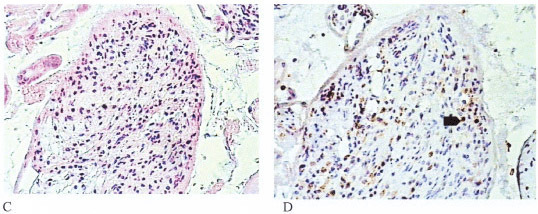Summary
Revista Brasileira de Ginecologia e Obstetrícia. 2005;27(8):442-449
DOI 10.1590/S0100-72032005000800002
PURPOSE: to establish the frequency of acute toxoplasmosis in pregnant women, vertical transmission rate and the perinatal results of the infected fetuses and also to evaluate the relationship between the most used maternal-fetal diagnostic tests for toxoplasmosis during pregnancy and the relationship between age and acute toxoplasmosis infection during pregnancy. METHODS: longitudinal prospective study of 32,512 pregnant women attended by The Pregnancy Protection Program of the State of Mato Grosso do Sul - Brazil, from November 2002 to October 2003. ELISA (IgG and IgM) and IgG avidity test were performed for maternal diagnosis and amniotic fluid PCR for fetal investigation of the infection. The relationship between data was analyzed statistically by the chi2 or two-sided Fisher's exact test in contingency tables. RESULTS: a 0.42% frequency of acute Toxoplasma gondii infection among pregnant population was found, where 92% were previously exposed and 8% were susceptible. Among IgM-positive pregnant women, the age ranged from 14 to 39 years, with a mean of 23±5.9 years. There was no statistically significant relationship between age and maternal acute T. gondii infection (p=0.73). The vertical transmission rate was 3.9%. A statistically significant relationship was shown (p=0.001) between a lower avidity IgG test (<30%) and the presence of fetal infection and a higher IgG avidity test (>60%) and the absence of fetal infection. There was a statistically significant association (p=0.001) between fetal infection (amniotic fluid PCR) and neonatal infection. CONCLUSIONS: maternal acute toxoplasmosis frequency was lower than the Brazilian national parameters, whereas vertical transmission rate did not differ from the rates found in other studies. The IgG avidity test, when associated with gestational age and the examination date, was useful to evaluate the therapeutical options and to consider the risk of vertical transmission when performed before 12 weeks. Positive PCR in amniotic fluid showed a positive relationship with the worst neonatal prognosis, being a specific method in diagnosing intrauterine fetal infection.
Summary
Revista Brasileira de Ginecologia e Obstetrícia. 2004;26(10):807-812
DOI 10.1590/S0100-72032004001000008
PURPOSE: placental villitis has been correlated with perinatal infection, although a percentage of cases remains etiologically unknown. The present study was aimed at the systematic morphological study of placentas for imunohistochemical characterization of villitis and assessment of its possible correlation with maternal and fetal outcome. METHODS: a hundred and twenty-eight placentas were studied. Gross examination was performed and all collected fragments were analyzed microscopically by the hematoxylin-eosin method. Villits was classified according to the inflammatory degree in to mild, moderate and severe. The immunohistochemical study to identify infectious agents was performed using monoclonal antibodies against Toxoplasma gondii and Cytomegalovirus. For inflammatory cell phenotype identification monoclonal antibodies against CD68, CD57, CD3, and CD20 were used. Statistical analysis was performed with the variables: maternal age and fetal gestational age, fetal and placental weight, and fetal and maternal outcomes. To compare the two groups we used the Mann-Whitney test and for proportions we used the chi2 test. The differences in the mean values between the treatment groups were considered statistically significant when p<0.05 (5%). RESULTS: villitis was identified in 11.7% of the cases. In 40% of the cases the children were stillborn (p=0.003). One case showed positive staining for toxoplasmosis while the remaining cases were negative. Imunohistochemical staining showed CD68+ cells, PanT+ cells and negative CD57 and PanB cells. CONCLUSION: we concluded that the intensity of the inflammatory process in the placenta was correlated with the severity of the fetal disease. The inflammatory cells in the villitis focus were macrophages; however, we could not identify infectious agents correlated with the villitis.

Summary
Revista Brasileira de Ginecologia e Obstetrícia. 2004;26(8):627-632
DOI 10.1590/S0100-72032004000800006
OBJECTIVE: to establish the rate of toxoplasmosis soroprevalence in postpartum women, attended in two hospitals of the Public Health System (SUS) in Cuiabá, and its correlation with age, previous abortion and women's knowledge of the disease. METHODS: a cross-sectional study including 205 women with ages from 14 to 43 (mean 22.4) years old, attended in these hospitals for two months, in the first or second days postpartum. Each woman answered a short questionnaire and had peripheral blood sample collected. Blood samples were stored at 20°C until assay. The seroprevalence was determined by quantitative detection of specific IgG antibody against Toxoplasma gondii, using a microparticle enzyme immunoassay. All samples were assayed at the same time. RESULTS: The average number of pregnancies in the women included in this study was 2.2, and the majority of them was pregnant for the first time. The seroprevalence found was 70.7% (165 of 205 women). No statistical correlation was found between seroprevalence and age (p = 0.967) or previous abortion (p = 0.82). Most of the women in this study (78%) did not know about toxoplasmosis and no statistical correlation was found between this condition and seroprevalence (p = 0.49). CONCLUSION: the high seroprevalence found in the present study is in accordance with surveys previously reported in our country and other developing countries. Among the women included in this study, an expressive number (29.3%) is still under risk of contamination. The lack of statistical correlation between seroprevalence and women's age, lack of knowledge about the disease and report of previous abortion is in accordance with some previous studies and in disagreement with others.